Particulate Matter Exposures under Five Different Transportation Modes during Spring Festival Travel Rush in China
Abstract
:1. Introduction
2. Methods
2.1. Sampling Routes
2.2. Measurements
3. Results and Discussion
3.1. During the SFTR
3.2. After the SFTR
4. Conclusions
Author Contributions
Funding
Data Availability Statement
Acknowledgments
Conflicts of Interest
References
- Weichenthal, S.; Van Ryswyk, K.; Kulka, R.; Sun, L.; Wallace, L.; Joseph, L. In-Vehicle Exposures to Particulate Air Pollution in Canadian Metropolitan Areas: The Urban Transportation Exposure Study. Environ. Sci. Technol. 2015, 49, 597–605. [Google Scholar] [CrossRef]
- Klepeis, N.E.; Nelson, W.C.; Ott, W.R.; Robinson, J.P.; Tsang, A.M.; Switzer, P.; Behar, J.V.; Hern, S.C.; Engelmann, W.H. The National Human Activity Pattern Survey (NHAPS): A resource for assessing exposure to environmental pollutants. J. Expo. Sci. Environ. Epidemiol. 2001, 11, 231–252. [Google Scholar] [CrossRef] [PubMed] [Green Version]
- Bi, X.; Luo, W. Analysis of travel characteristics and transportation improvement strategies of small and medium-sized cities. Technol. Econ. Area Commun. 2018, 20, 28–31. [Google Scholar] [CrossRef]
- Asadi, S.; Bouvier, N.; Wexler, A.S.; Ristenpart, W.D. The coronavirus pandemic and aerosols: Does COVID-19 transmit via expiratory particles? Aerosol Sci. Technol. 2020, 54, 635–638. [Google Scholar] [CrossRef] [PubMed] [Green Version]
- Prather, K.A.; Wang, C.C.; Schooley, R.T. Reducing transmission of SARS-CoV-2. Science 2020, 368, 1422–1424. [Google Scholar] [CrossRef] [PubMed]
- Morawska, L.; Milton, D.K. It Is Time to Address Airborne Transmission of Coronavirus Disease 2019 (COVID-19). Clin. Infect. Dis. 2020, 71, 2311–2313. [Google Scholar] [CrossRef]
- Morawska, L.; Tang, J.W.; Bahnfleth, W.; Bluyssen, P.M.; Boerstra, A.; Buonanno, G.; Cao, J.; Dancer, S.; Floto, A.; Franchimon, F.; et al. How can airborne transmission of COVID-19 indoors be minimised? Environ. Int. 2020, 142, 105832. [Google Scholar] [CrossRef]
- Ahlawat, A.; Wiedensohler, A.; Mishra, S.K. An Overview on the Role of Relative Humidity in Airborne Transmission of SARS-CoV-2 in Indoor Environments. Aerosol Air Qual. Res. 2020, 20, 1856–1861. [Google Scholar] [CrossRef]
- Qiu, Z.; Song, J.; Xu, X.; Luo, Y.; Zhao, R.; Zhou, W.; Xiang, B.; Hao, Y. Commuter exposure to particulate matter for different transportation modes in Xi’an, China. Atmos. Pollut. Res. 2017, 8, 940–948. [Google Scholar] [CrossRef]
- Goel, V.; Mishra, S.K.; Ahlawat, A.; Sharma, C.; Vijayan, N.; Radhakrishnan, S.R.; Dimri, A.P.; Kotnala, R.K. Effect of Reduced Traffic Density on Characteristics of Particulate Matter Over Delhi. Curr. Sci. 2018, 115, 315–319. [Google Scholar] [CrossRef]
- Yang, T.; Zhang, P.; Xu, B.; Xiong, J. Predicting VOC emissions from materials in vehicle cabins: Determination of the key parameters and the influence of environmental factors. Int. J. Heat Mass Transf. 2017, 110, 671–679. [Google Scholar] [CrossRef]
- Maji, K.J.; Arora, M.; Dikshit, A.K. Burden of disease attributed to ambient PM2.5 and PM10 exposure in 190 cities in China. Environ. Sci. Pollut. Res. 2017, 24, 11559–11572. [Google Scholar] [CrossRef] [PubMed]
- Tan, S.H.; Roth, M.; Velasco, E. Particle exposure and inhaled dose during commuting in Singapore. Atmos. Environ. 2017, 170, 245–258. [Google Scholar] [CrossRef]
- Zhao, J.; Bo, L.; Gong, C.; Cheng, P.; Kan, H.; Xie, Y.; Song, W. Preliminary study to explore gene-PM2.5 interactive effects on respiratory system in traffic policemen. Int. J. Occup. Med. Environ. Health 2015, 28, 971–983. [Google Scholar] [CrossRef] [PubMed]
- Zhao, J.; Gao, Z.; Tian, Z.; Xie, Y.; Xin, F.; Jiang, R.; Kan, H.; Song, W. The biological effects of individual-level PM2.5 exposure on systemic immunity and inflammatory response in traffic policemen. Occup. Environ. Med. 2013, 70, 426–431. [Google Scholar] [CrossRef]
- Xu, H.; Song, N.; Ji, G.; Shi, L.; Zhang, Q.; Guo, M. Personal exposure and health risk assessment of carbonyls in family cars and public transports—a comparative study in Nanjing, China. Environ. Sci. Pollut. Res. 2017, 24, 26111–26119. [Google Scholar] [CrossRef]
- Kam, W.; Delfino, R.J.; Schauer, J.J.; Sioutas, C. A comparative assessment of PM2.5 exposures in light-rail, subway, freeway, and surface street environments in Los Angeles and estimated lung cancer risk. Environ. Sci. Process. Impacts 2012, 15, 234–243. [Google Scholar] [CrossRef] [PubMed]
- Gómez-Perales, J.; Colvile, R.; Nieuwenhuijsen, M.; Fernández-Bremauntz, A.; Gutiérrez-Avedoy, V.; Páramo-Figueroa, V.; Blanco-Jiménez, S.; Bueno-López, E.; Mandujano, F.; Bernabé-Cabanillas, R.; et al. Commuters’ exposure to PM2.5, CO, and benzene in public transport in the metropolitan area of Mexico City. Atmos. Environ. 2004, 38, 1219–1229. [Google Scholar] [CrossRef]
- Yan, C.; Zheng, M.; Yang, Q.; Zhang, Q.; Qiu, X.; Zhang, Y.; Fu, H.; Li, X.; Zhu, T.; Zhu, Y. Commuter exposure to particulate matter and particle-bound PAHs in three transportation modes in Beijing, China. Environ. Pollut. 2015, 204, 199–206. [Google Scholar] [CrossRef]
- Ruttens, D.; Verleden, S.E.; Bijnens, E.M.; Winckelmans, E.; Gottlieb, J.; Warnecke, G.; Meloni, F.; Morosini, M.; Van Der Bij, W.; Verschuuren, E.A.; et al. An association of particulate air pollution and traffic exposure with mortality after lung transplantation in Europe. Eur. Respir. J. 2016, 49, 1600484. [Google Scholar] [CrossRef]
- Television, C.C. Nanjing Railway Station Sent 210,000 Passengers on the First Day of Spring Festival Transport. Available online: https://haokan.baidu.com/v?pd=wisenatural&vid=13281730742068025235 (accessed on 11 January 2021).
- World Health Organization. Air Quality Guidelines: Global Update 2005: Particulate Matter, Ozone, Nitrogen Dioxide, and Sulfur Dioxide; World Health Organization: Geneva, Switzerland, 2006; pp. 277–279. [Google Scholar]
- Chan, L.; Lau, W.; Zou, S.; Cao, Z.; Lai, S. Exposure level of carbon monoxide and respirable suspended particulate in public transportation modes while commuting in urban area of Guangzhou, China. Atmos. Environ. 2002, 36, 5831–5840. [Google Scholar] [CrossRef]
- Onat, B.; Stakeeva, B. Personal exposure of commuters in public transport to PM2.5 and fine particle counts. Atmos. Pollut. Res. 2013, 4, 329–335. [Google Scholar] [CrossRef] [Green Version]
- Wu, D.-L.; Lin, M.; Chan, C.-Y.; Li, W.-Z.; Tao, J.; Li, Y.-P.; Sang, X.-F.; Bu, C.-W. Influences of Commuting Mode, Air Conditioning Mode and Meteorological Parameters on Fine Particle (PM2.5) Exposure Levels in Traffic Microenvironments. Aerosol Air Qual. Res. 2013, 13, 709–720. [Google Scholar] [CrossRef] [Green Version]
- Kumar, P.; Patton, A.; Durant, J.L.; Frey, H.C. A review of factors impacting exposure to PM2.5, ultrafine particles and black carbon in Asian transport microenvironments. Atmos. Environ. 2018, 187, 301–316. [Google Scholar] [CrossRef]
- Kumar, P.; Rivas, I.; Singh, A.P.; Ganesh, V.J.; Ananya, M.; Frey, H.C. Dynamics of coarse and fine particle exposure in transport microenvironments. npj Clim. Atmos. Sci. 2018, 1, 11. [Google Scholar] [CrossRef]
- Suárez, L.; Mesías, S.; Iglesias, V.; Silva, C.; Cáceres, D.D.; Ruiz-Rudolph, P. Personal exposure to particulate matter in commuters using different transport modes (bus, bicycle, car and subway) in an assigned route in downtown Santiago, Chile. Environ. Sci. Process. Impacts 2014, 16, 1309–1317. [Google Scholar] [CrossRef] [PubMed]
- Andersen, M.H.G.; Johannesson, S.; Fonseca, A.S.; Clausen, P.A.; Saber, A.T.; Roursgaard, M.; Loeschner, K.; Koponen, I.K.; Loft, S.; Vogel, U.; et al. Exposure to Air Pollution inside Electric and Diesel-Powered Passenger Trains. Environ. Sci. Technol. 2019, 53, 4579–4587. [Google Scholar] [CrossRef] [PubMed] [Green Version]
- Cha, Y.; Tu, M.; Elmgren, M.; Silvergren, S.; Olofsson, U. Factors affecting the exposure of passengers, service staff and train drivers inside trains to airborne particles. Environ. Res. 2018, 166, 16–24. [Google Scholar] [CrossRef]
- Cha, Y.; Abbasi, S.; Olofsson, U. Indoor and outdoor measurement of airborne particulates on a commuter train running partly in tunnels. Proc. Inst. Mech. Eng. Part F J. Rail Rapid Transit 2016, 232, 3–13. [Google Scholar] [CrossRef]
- Chaney, R.A.; Sloan, C.D.; Cooper, V.C.; Robinson, D.R.; Hendrickson, N.R.; Mccord, T.A.; Johnston, J.D. Personal exposure to fine particulate air pollution while commuting: An examination of six transport modes on an urban arterial roadway. PLoS ONE 2017, 12, e0188053. [Google Scholar] [CrossRef]
- Kam, W.; Cheung, K.; Daher, N.; Sioutas, C. Particulate matter (PM) concentrations in underground and ground-level rail systems of the Los Angeles Metro. Atmos. Environ. 2011, 45, 1506–1516. [Google Scholar] [CrossRef]
- Ham, W.; Vijayan, A.; Schulte, N.; Herner, J.D. Commuter exposure to PM2.5, BC, and UFP in six common transport microenvironments in Sacramento, California. Atmos. Environ. 2017, 167, 335–345. [Google Scholar] [CrossRef]
- Nyhan, M.; McNabola, A.; Misstear, B. Comparison of particulate matter dose and acute heart rate variability response in cyclists, pedestrians, bus and train passengers. Sci. Total. Environ. 2014, 468-469, 821–831. [Google Scholar] [CrossRef]
- Knibbs, L.; De Dear, R.J. Exposure to ultrafine particles and PM2.5 in four Sydney transport modes. Atmos. Environ. 2010, 44, 3224–3227. [Google Scholar] [CrossRef] [Green Version]
- Li, T.-T.; Bai, Y.-H.; Liu, Z.-R.; Li, J.-L. In-train air quality assessment of the railway transit system in Beijing: A note. Transp. Res. Part D Transp. Environ. 2007, 12, 64–67. [Google Scholar] [CrossRef]
- Chan, L.; Lau, W.; Lee, S.-C.; Chan, C. Commuter exposure to particulate matter in public transportation modes in Hong Kong. Atmos. Environ. 2002, 36, 3363–3373. [Google Scholar] [CrossRef]
- Shen, J.; Gao, Z. Commuter exposure to particulate matters in four common transportation modes in Nanjing. Build. Environ. 2019, 156, 156–170. [Google Scholar] [CrossRef]
- Ozgen, M.S.; Ripamonti, G.; Malandrini, A.; Ragettli, M.S.; Lonati, G. Particle number and mass exposure concentrations by commuter transport modes in Milan, Italy. AIMS Environ. Sci. 2016, 3, 168–184. [Google Scholar] [CrossRef] [Green Version]
- Goel, R.; Gani, S.; Guttikunda, S.; Wilson, D.; Tiwari, G. On-road PM2.5 pollution exposure in multiple transport microenvironments in Delhi. Atmos. Environ. 2015, 123, 129–138. [Google Scholar] [CrossRef]
- Li, Z.; Che, W.; Frey, H.C.; Lau, A.K.; Lin, C. Characterization of PM2.5 exposure concentration in transport microenvironments using portable monitors. Environ. Pollut. 2017, 228, 433–442. [Google Scholar] [CrossRef]
- Adams, H.; Nieuwenhuijsen, M.; Colvile, R. Determinants of fine particle (PM2.5) personal exposure levels in transport microenvironments, London, UK. Atmos. Environ. 2001, 35, 4557–4566. [Google Scholar] [CrossRef]
- Kolluru, S.S.R.; Patra, A.K.; Kumar, P. Determinants of commuter exposure to PM2.5 and CO during long-haul journeys on national highways in India. Atmos. Pollut. Res. 2019, 10, 1031–1041. [Google Scholar] [CrossRef]
- Okokon, E.O.; Taimisto, P.; Turunen, A.W.; Amoda, O.A.; Fasasi, A.E.; Adeyemi, L.G.; Juutilainen, J.; Lanki, T. Particulate air pollution and noise: Assessing commuter exposure in Africa’s most populous city. J. Transp. Health 2018, 9, 150–160. [Google Scholar] [CrossRef]
- Brook, R.D.; Rajagopalan, S.; Pope, I.C.A.; Brook, J.R.; Bhatnagar, A.; Diez-Roux, A.V.; Holguin, F.; Hong, Y.; Luepker, R.V.; Mittleman, M.; et al. Particulate Matter Air Pollution and Cardiovascular Disease. Circulation 2010, 121, 2331–2378. [Google Scholar] [CrossRef] [PubMed] [Green Version]
- Yuan, Z.H.; Hou, Y.J.; Zhao, C.; Li, Y. Dynamicly Observing Influence of Ambient PM2.5 on Human Lymphocyte Subsets. Appl. Mech. Mater. 2014, 508, 286–289. [Google Scholar] [CrossRef]
- Yu, N.; Shu, S.; Lin, Y.; She, J.; Ip, H.S.S.; Qiu, X.; Zhu, Y. High efficiency cabin air filter in vehicles reduces drivers’ roadway particulate matter exposures and associated lipid peroxidation. PLoS ONE 2017, 12, e0188498. [Google Scholar] [CrossRef] [PubMed]
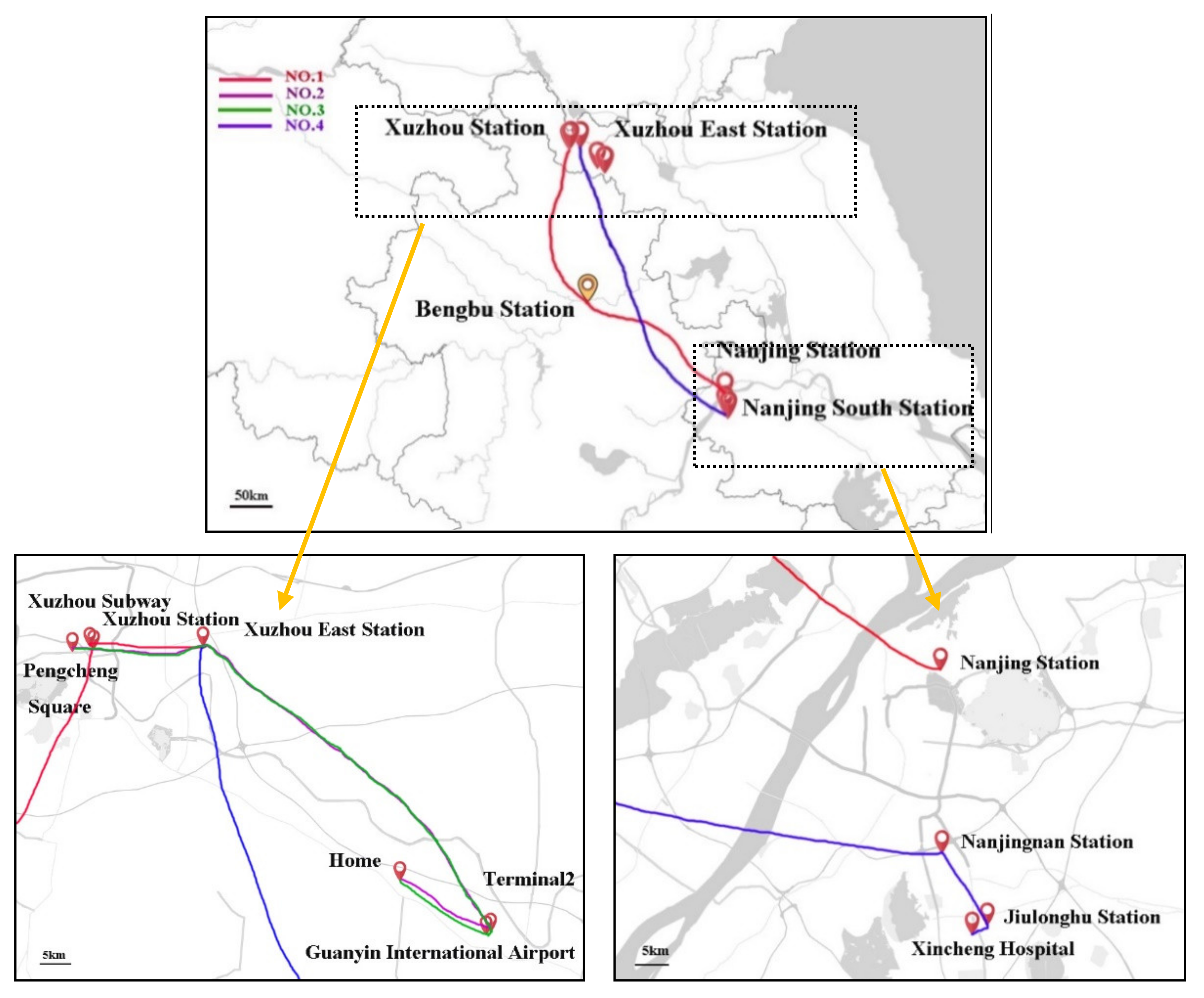


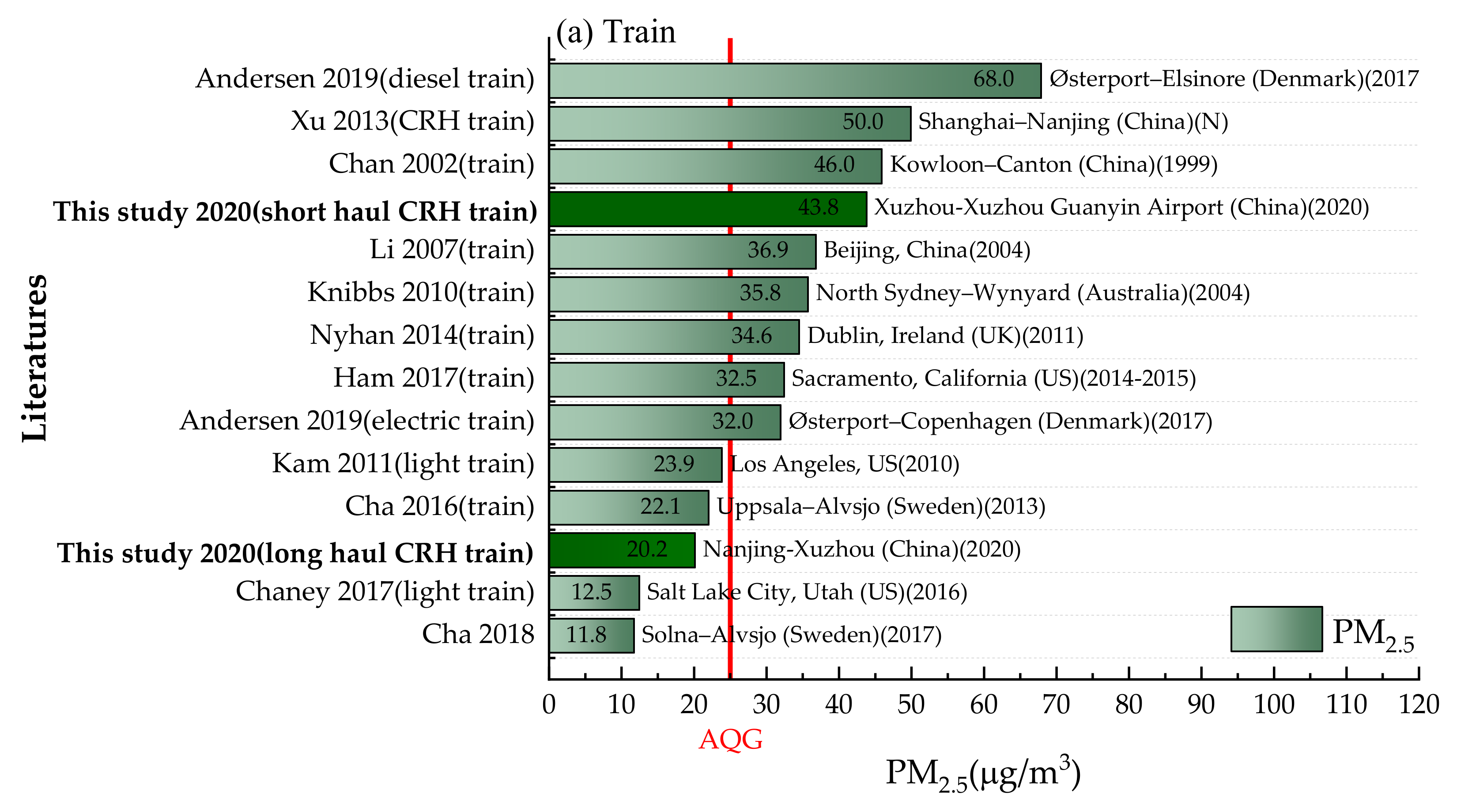
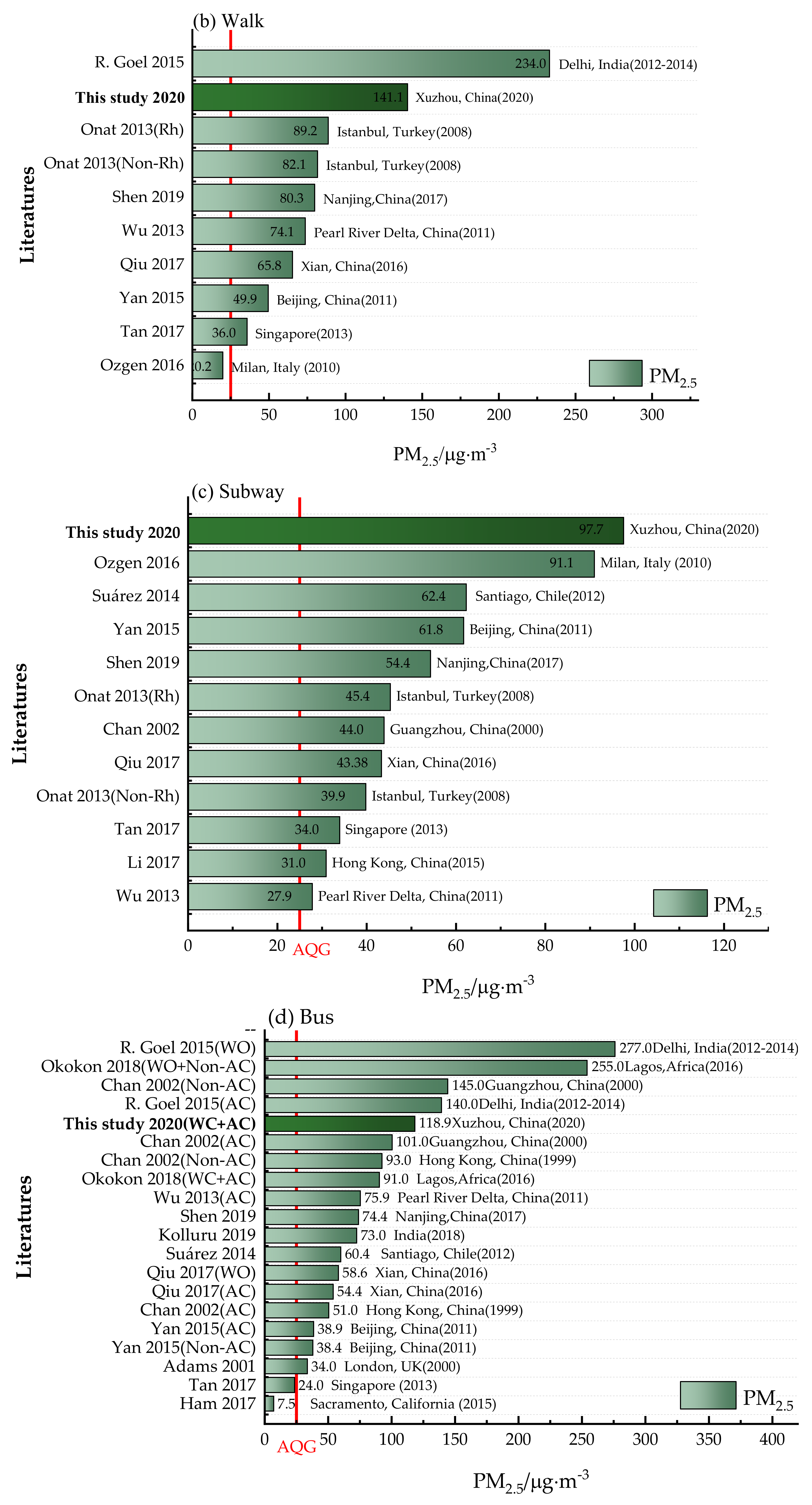
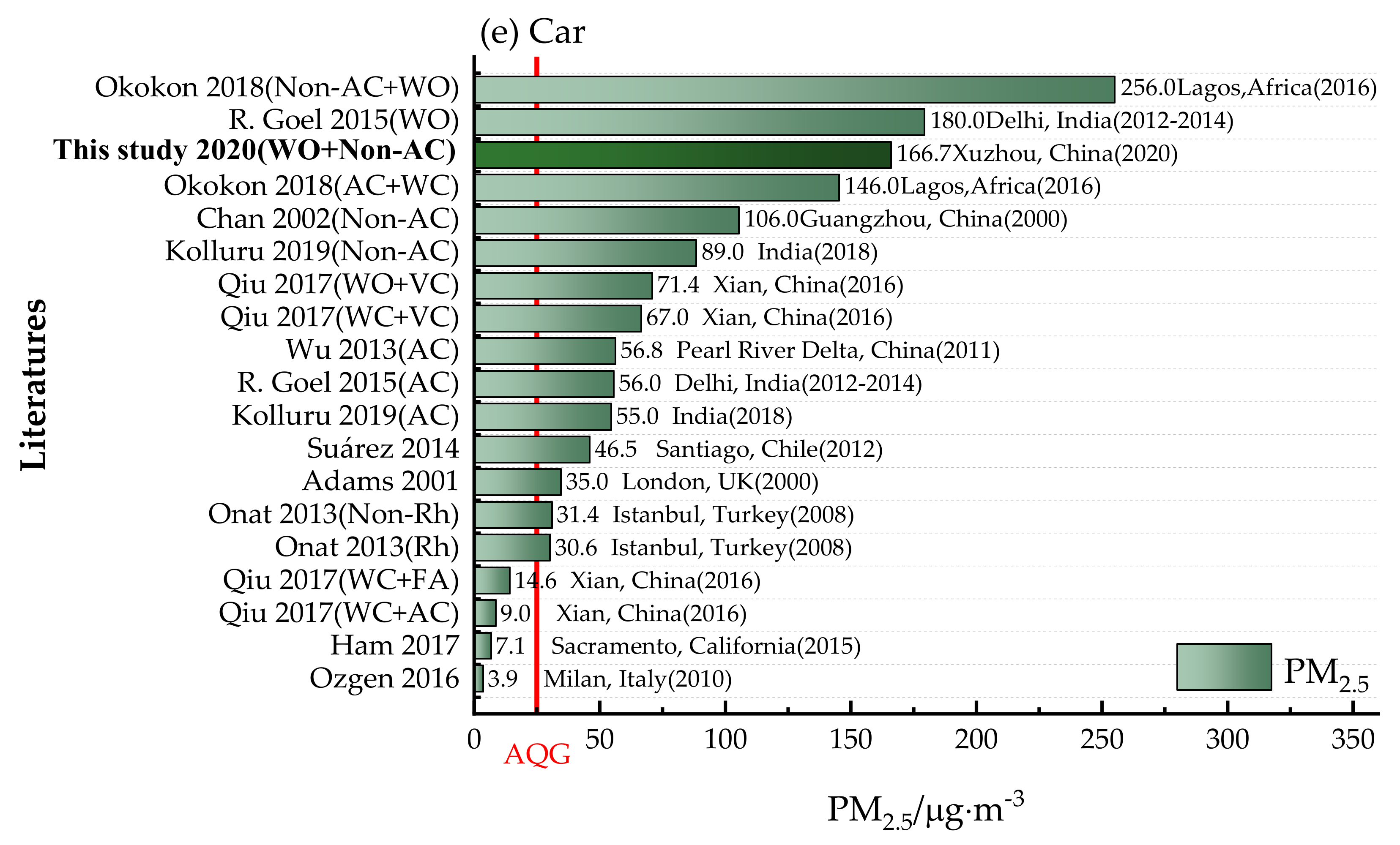
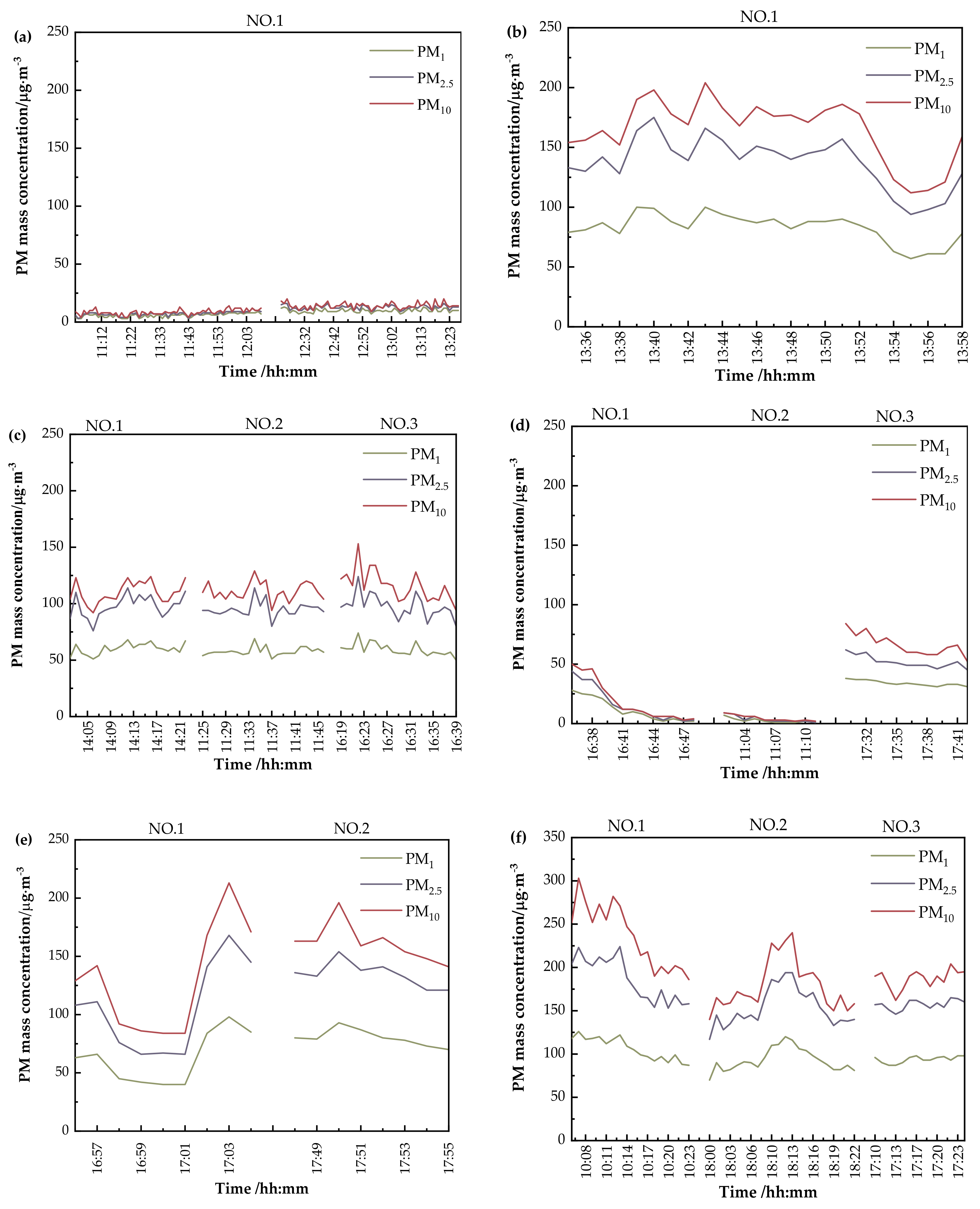
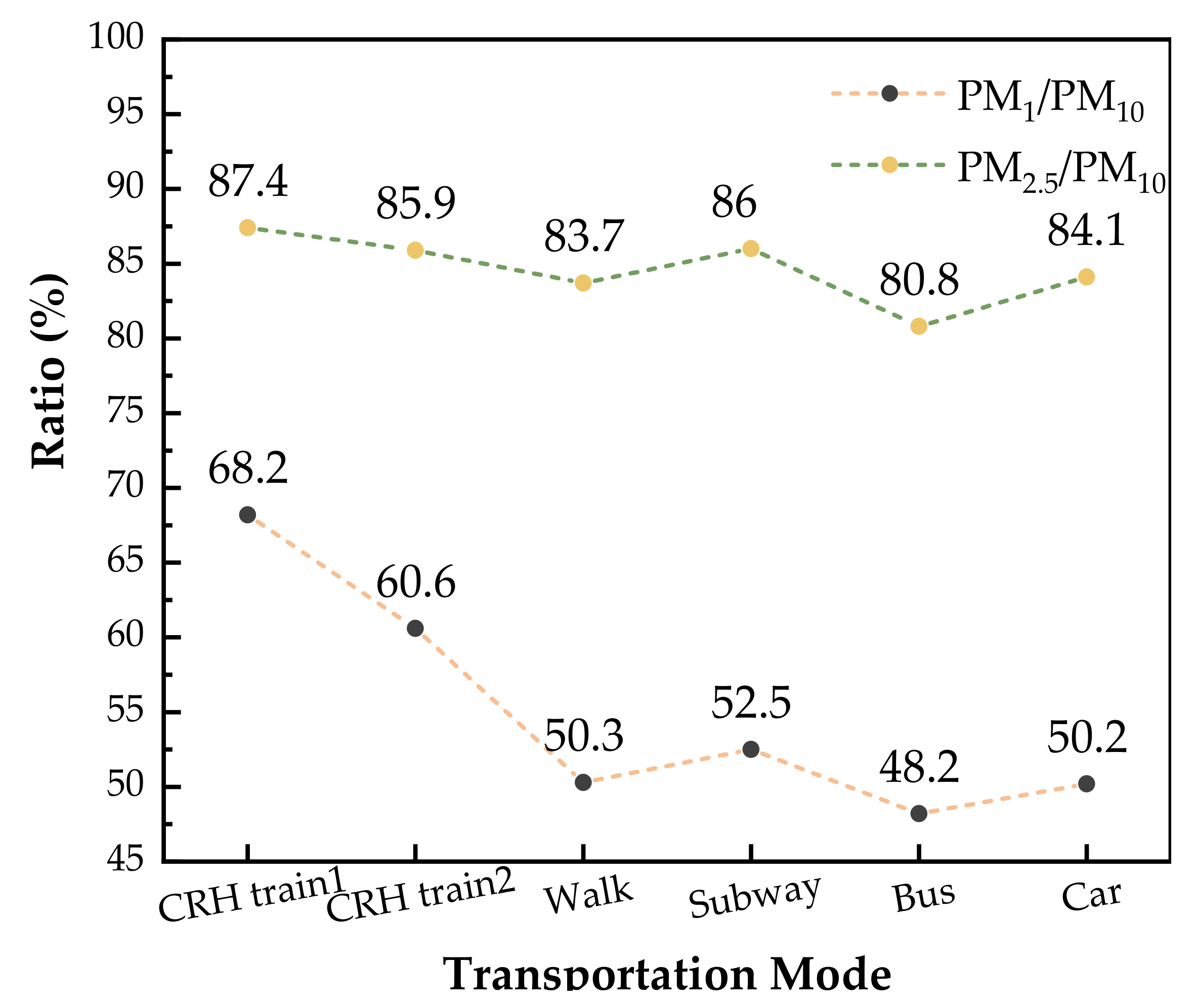
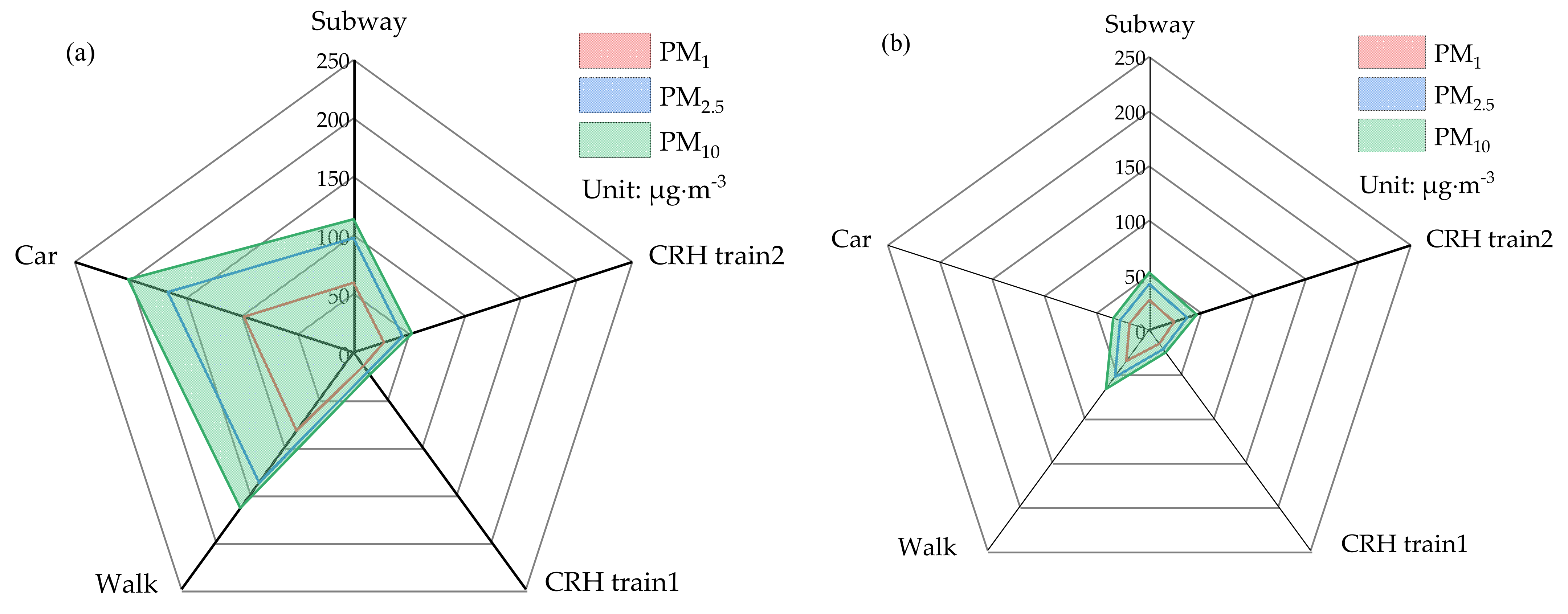
| Transportation Modes | NO.1 (19 January 2020) | NO.2 (21 January 2020) | NO.3 (21 January 2020) | NO.4 (6 May 2020) |
|---|---|---|---|---|
| CRH train 1 | Nanjing-Xuzhou | - | - | Xuzhou East-Nanjing South |
| Walk | Xuzhou-Xuzhou Subway | - | - | Jiulonghu-Xincheng Hospital |
| Subway | Xuzhou Subway-Xuzhou East | Xuzhou East-Pengcheng Square | Pengcheng Square-Xuzhou East | Nanjing South-Jiulonghu |
| CRH train 2 | Xuzhou East-Guanyin Airport | Guanyin Airport-Xuzhou East | Xuzhou East-Guanyin Airport | Guanyin Airport-Xuzhou East |
| Bus | Guanyin Airport-Terminal 2 | - | Guanyin Airport-Terminal 2 | - |
| Car | Terminal 2-Home | Home-Guanyin Airport | Guanyin Airport-Home | Home-Guanyin Airport |
| Transportation Modes | Ventilation Type | Routes | Duration (min) | Distance (km) | Note |
|---|---|---|---|---|---|
| CRH train 1 | AC | NO.1 | 150 | 283.5 | - |
| NO.4 | 222 | 283.5 | - | ||
| Walk | Open air | NO.1 | 24 | 0.4 | 8 lanes in both directions |
| NO.4 | 9 | 0.2 | Single direction | ||
| Subway | AC | NO.1 | 27 | 9.0 | - |
| NO.2 | 30 | 9.0 | - | ||
| NO.3 | 33 | 9.0 | - | ||
| NO.4 | 20 | 8.9 | - | ||
| CRH train 2 | AC | NO.1 | 16 | 35.3 | - |
| NO.2 | 15 | 35.3 | - | ||
| NO.3 | 16 | 35.3 | - | ||
| NO.4 | 17 | 35.3 | - | ||
| Bus | AC | NO.1 | 9 | 2.0 | 2 lanes in both directions |
| NO.3 | 9 | 2.0 | |||
| Car | Non-AC+WO | NO.1 | 15 | 9.2 | 6 lanes in both directions |
| Non-AC+WO | NO.2 | 20 | 9.2 | ||
| Non-AC+WO | NO.3 | 23 | 9.2 | ||
| AC | NO.4 | 34 | 9.2 |
| Instrument | Parameters Collected | Interval | Range | Accuracy |
|---|---|---|---|---|
| BoHu model BH1-B3 | PM1/PM2.5/PM10 | 1 min | 0–1999 μg·m−3 | ±15% |
| RH | 0–100% | ±5% | ||
| T | −20–99 °C | ±2 °C |
| Route | NO.1 | NO.2 | NO.3 | NO.4 | ||||
|---|---|---|---|---|---|---|---|---|
| T/°C | RH/% | T/°C | RH/% | T/°C | RH/% | T/°C | RH/% | |
| CRH train 1 | 23.0 | 41.0 | - | - | - | - | 25.7 | 47.9 |
| Walk | 20.9 | 31.5 | - | - | - | - | 26.2 | 48.7 |
| Subway | 20.1 | 38.6 | 13.5 | 52.1 | 15.3 | 53.7 | 25.9 | 50.5 |
| CRH train 2 | 22.1 | 36.3 | 13.6 | 64.4 | 19.5 | 44.1 | 25.1 | 50.3 |
| Bus | 21.2 | 35.8 | - | - | 17.3 | 54.1 | - | - |
| Car | 19.0 | 43.7 | 12.9 | 52.0 | 18.0 | 49.2 | 25.3 | 48.6 |
| PM1 | PM2.5 | PM10 | |||||||
|---|---|---|---|---|---|---|---|---|---|
| t | df | Sig | t | df | Sig | t | df | Sig | |
| CRH train1 | −0.19 | 194.25 | 0.85 | 0.15 | 194.98 | 0.88 | 0.12 | 204.45 | 0.91 |
| CRH train2 | 0.36 | 17.46 | 0.72 | 0.45 | 17.33 | 0.66 | 0.22 | 18.21 | 0.83 |
| Subway | 13.46 | 45 | 0.00 | 12.81 | 45 | 0.00 | 10.78 | 45 | 0.00 |
| Car | 21.46 | 40.24 | 0.00 | 42.68 | 45.47 | 0.00 | 34.13 | 45.94 | 0.00 |
| Walking | 8.40 | 42 | 0.00 | 17.87 | 29.39 | 0.00 | 16.61 | 30.64 | 0.00 |
Publisher’s Note: MDPI stays neutral with regard to jurisdictional claims in published maps and institutional affiliations. |
© 2021 by the authors. Licensee MDPI, Basel, Switzerland. This article is an open access article distributed under the terms and conditions of the Creative Commons Attribution (CC BY) license (https://creativecommons.org/licenses/by/4.0/).
Share and Cite
Zhang, Y.; Yu, N.; Zhang, M.; Ye, Q. Particulate Matter Exposures under Five Different Transportation Modes during Spring Festival Travel Rush in China. Processes 2021, 9, 1133. https://doi.org/10.3390/pr9071133
Zhang Y, Yu N, Zhang M, Ye Q. Particulate Matter Exposures under Five Different Transportation Modes during Spring Festival Travel Rush in China. Processes. 2021; 9(7):1133. https://doi.org/10.3390/pr9071133
Chicago/Turabian StyleZhang, Yao, Nu Yu, Mengya Zhang, and Quan Ye. 2021. "Particulate Matter Exposures under Five Different Transportation Modes during Spring Festival Travel Rush in China" Processes 9, no. 7: 1133. https://doi.org/10.3390/pr9071133
APA StyleZhang, Y., Yu, N., Zhang, M., & Ye, Q. (2021). Particulate Matter Exposures under Five Different Transportation Modes during Spring Festival Travel Rush in China. Processes, 9(7), 1133. https://doi.org/10.3390/pr9071133







